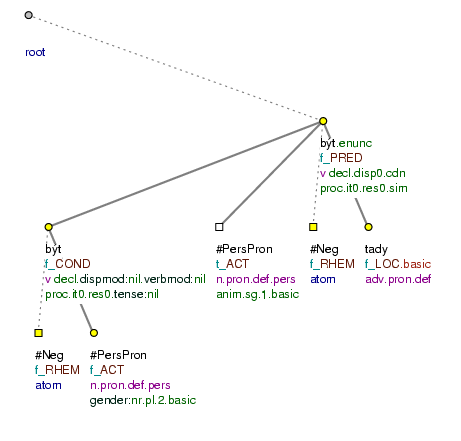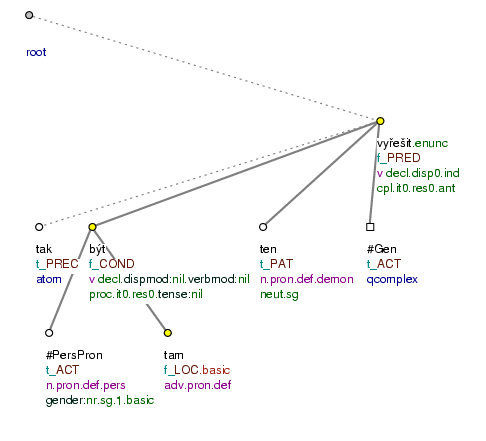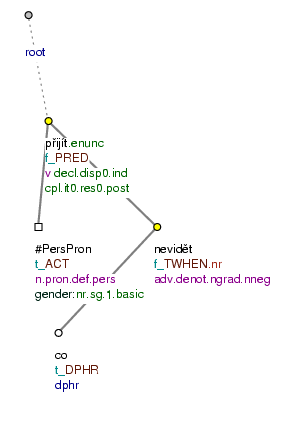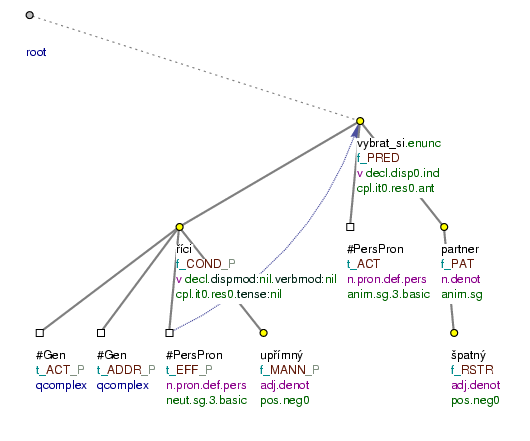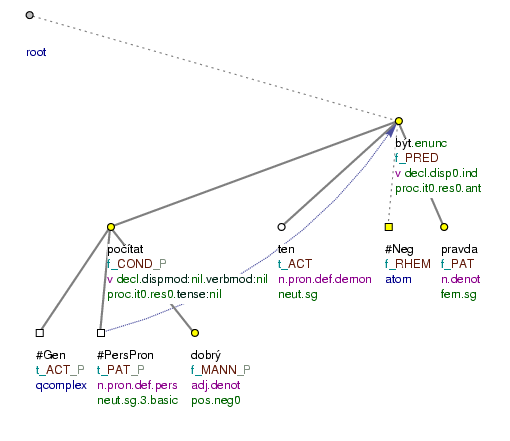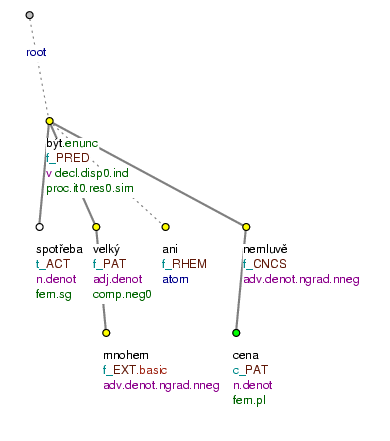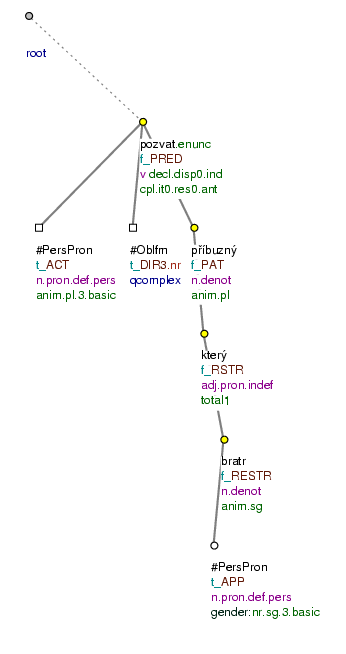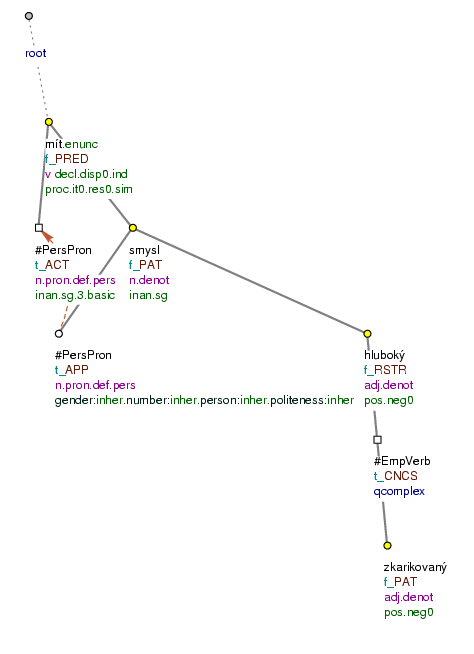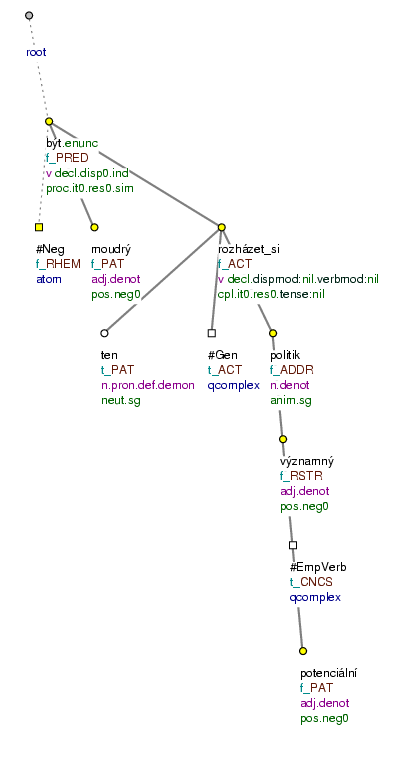Clauses that are considered verbal are described thoroughly in Section 4.1, "Verbal clauses". The present section offers more precise rules for the annotation of certain dependent verbal clauses that lack a finite verb form in their surface structure. These are:
-
dependent infinitival constructions (see Section 5.1.1, "Dependent infinitival constructions"),
-
dependent participial constructions (see Section 5.1.2, "Dependent participial constructions"),
-
transgressive (gerund) constructions (see Section 5.1.3, "Transgressive (gerund) constructions"),
-
constructions with adjectives connected by a subordinating conjunction (see Section 5.1.4, "Constructions with adjectives connected by a subordinating conjunction").
Ellipsis of the governing verb of a dependent clause. Dependent verbal clauses with the ellipsis of the governing verb are analyzed according to the rules in Section 12.1.1, "Ellipsis of the governing verb".
Example:
Řekl: Nač {#EmpVerb.EFF} ten spěch? (=He said: Why the hurry?) Fig. 6.38
Oslava se vydařila, protože Jirka hrál.CAUS na kytaru a Hana { hrát.CAUS} na klavír. (=The party was good because Jirka played the guitar and Hanka the piano)
Figure 6.38. Dependent clause with ellipsis of the governing verb
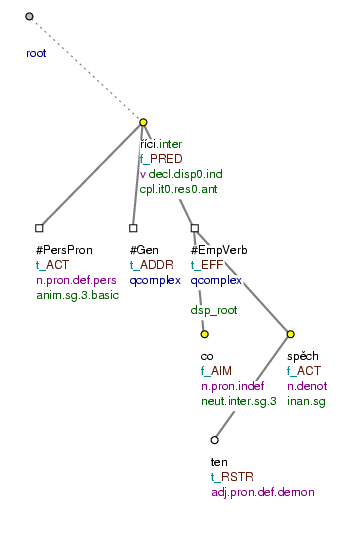
Řekl: Nač ten spěch? (=lit. (He) said: Why the hurry?)
If there is an infinitive in place of a finite verb form in a dependent clause, the node for the infinitive is the effective root node of the dependent clause.
Infinitival constructions can be both valency modifications of a word in the governing clause (a content clause) or they can express various adverbial meanings (an adverbial clause). A special case is an infinitival construction expressing a condition (see Section 5.1.1.1, "Condition expressed by an infinitive"). Special rules apply in case of frozen infinitival constructions - see Section 5.1.1.2, "Frozen infinitival constructions".
The infinitive is assigned a valency frame.
NB! Infinitival constructions often depend on a control verb or noun; the subject of the infinitive is then controlled by a valency modification of the verb or noun. The newly established node for the controllee has the t-lemma substitute #Cor (see Section 2.4, "Control"). If there is no control involved, the newly established node for the subject of the infinitive has the #Gen t-lemma. However, it can also have the #PersPron t-lemma if it is possible to determine the reference of the subject from the context (cf. Table 9.4, "Subjects of infinitives: possible t-lemmas").
Possible modal meanings of the infinitival construction are encoded in the appropriate grammatemes (see Section 5.10, "The deontmod grammateme (deontic modality)").
Examples:
Máš dvě možnosti, jak získat.PAT
Rodiče se dozvěděli, jak s dítětem zacházet.PAT (=The parents learned how to treat the child) Fig. 6.40
Nevím, kam jít.PAT
<Jestliže> odejít.COND , tak hned. (=lit. If to leave, so immediately; meaning: if we are supposed to leave...) Fig. 6.41
Infinitival constructions usually express modal meanings (the construction is a wish, exclamation etc.) Cf.:
-
Nevím, kam jít.
= I do not know where I shall/should/must go.
-
Rodiče se dozvěděli, jak s dítětem zacházet.
= The parents learned how they shall/should/must treat the child.
!!! The modal meanings of infinitival constructions have not been captured in PDT so far: the nodes representing the infinitive have the decl value in their deontmod grammateme (see Section 5.10, "The deontmod grammateme (deontic modality)")
Figure 6.39. Dependent infinitival construction
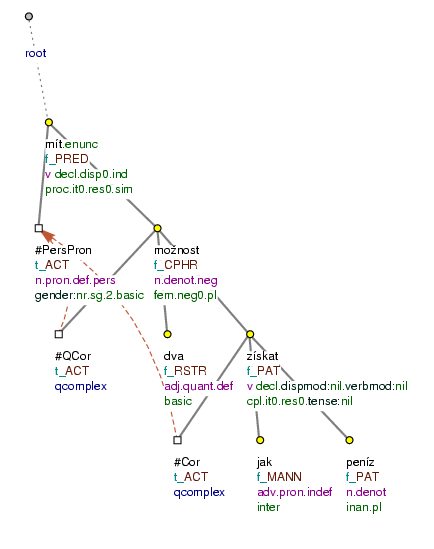
Máš dvě možnosti, jak získat peníze. (=lit. (You) have two possibilities how to_get money)
Figure 6.40. Dependent infinitival construction
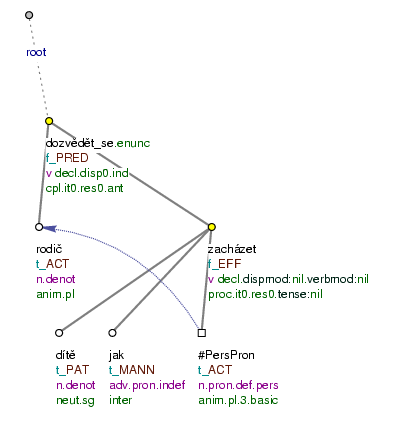
Rodiče se dozvěděli, jak s dítětem zacházet. (=lit. Parents REFL learned how with child to_treat)
Figure 6.41. Dependent infinitival construction
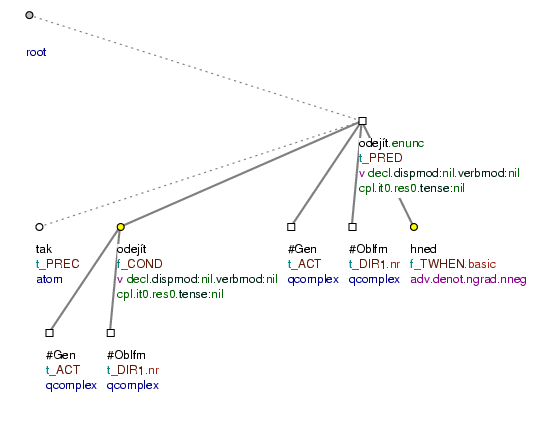
Jestliže odejít, tak hned. (=lit. If to_leave then immediately)
A special case of dependent infinitival constructions are infinitival constructions expressing a condition, which are connected to the governing clause without the use of a subordinating conjunction.
The infinitive gets the functor COND.
!!! The verbmod grammateme of the infinitive (see Section 5.9, "The verbmod grammateme (verbal modality)") should get the cdn value; nonetheless, the assigned value is ind so far.
There is no grammatical coreference involved. The newly established node for the subject of the infinitive has the t-lemma substitute #Gen or #PersPron. The subject of the infinitive can also be present on the surface.
Examples:
Nebýt.COND vás, nebyl bych tady. (=If it wasn't for you (lit. Not_to_be you), I wouldn't be here) Fig. 6.42
Já tam být.COND , tak se to vyřešilo. (=If I was there (lit. I to_be there), the problem would be solved) Fig. 6.43
Nenastat.COND ten problém, ještě bych tam pracoval. (=If it wasn't for the problem (lit. Not_to_happen the problem) I would still work there)
(Já/On) Nenapsat.COND tu knihu, nic by po něm nezůstalo. (=If I/he didn't write (=lit. Not_to_write) the book he would leave here nothing)
Být.COND tu Honza, tak jsme toho udělali, mnohem víc. (=If Honza had been here (lit. To_be here Honza) we would have done much more)
Some infinitival constructions are lexicalized to such an extent that they are considered adverbs (sempos=adv), with limited valency requirements.
Frozen verbal (not only infinitival) constructions are often taken to be non-verbal idioms (phrasemes; see Section 8.2, "Verbal idioms").
The t-lemma of such a frozen infinitive is equal to its surface form (i.e. including e.g. the negative particle ne). The frozen infinitive gets a functor according to its position in the sentence.
Example:
Přijdu,co.DPHR nevidět.TWHEN (=I'll come very soon; lit. what not_to_see) Fig. 6.44
Regular (agreeing) dependent participial constructions are analyzed as:
-
argument.
The effective root node of the participial construction gets an argument functor if it occupies a valency position. The argument position always corresponds to that of the traditional predicative complement, i.e. it is a dual dependency argument position Section 1.2, "Non-dependency edges").
Example:
Zůstává inspirován.
PATčlánkem. (=He remains (to be) inspired by the article) -
predicative complement.
If the participial construction occupies a non-valency position, it is not introduced by a connective and expresses no adverbial meanings, it is analyzed as a predicative complement.
For the annotation rules regarding predicative complements, see Section 10, "Predicative complement (dual dependency)".
Examples:
Profesor, inspirován.
COMPLčlánkem, přednášel o nových problémech. (=The professor, inspired by the article, had a lecture on the new issues) Fig. 6.45Profesor přednášel o nových problémech, inspirován.
COMPLčlánkem .(=The professor had a lecture on the new issues, inspired by the article) -
adverbial clause.
Exceptionally, the participial construction can also have adverbial meanings, especially if introduced by a subordinating conjunction.
Example:
Dům, ač zadlužen.
CNCS, byl prodán velmi rychle . (=The house, although indebted, was sold very quickly) Fig. 6.46
The effective root node of the dependent participial construction always depends on a verb; its t-lemma is equal to the infinitive and it has an appropriate functor. The participle is assigned a valency frame. The subject of the participle is always in a grammatical coreference relation with the subject of the governing verb (see Section 2.3, "Coreference with verbal modifications that have dual dependency").
Figure 6.45. Dependent participial construction
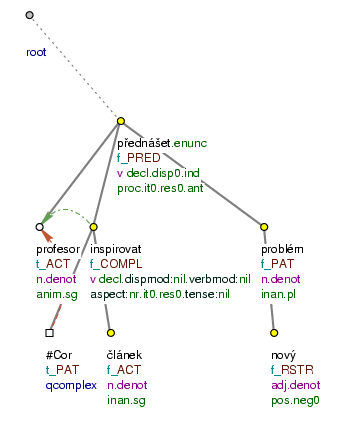
Profesor, inspirován článkem, přednášel o nových problémech. (=lit. Professor, inspired by_article, had_lecture on new issues)
Figure 6.46. Dependent participial construction
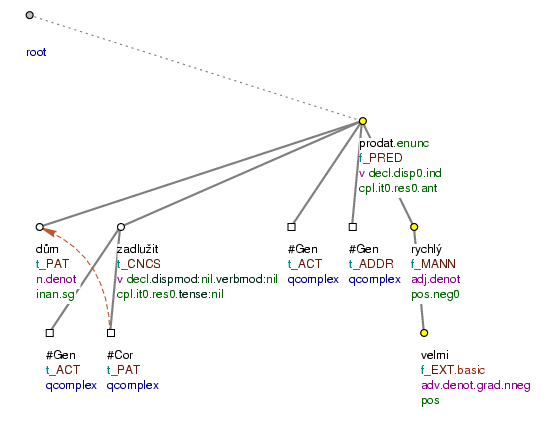
Dům, ač zadlužen, byl prodán, velmi rychle. (=lit. House, athough indebted, was sold very quickly)
Participial construction vs. adjective phrase. Participial constructions cannot be always distinguished from adjective phrases with the short forms of the adjective due to the surface identity of the participle and the short form of the adjective. These cases are usually treated as participial. An exception are the constructions expressing the resultant state (see Section 2.2.1, "Verbonominal predicate vs. periphrastic passive").
These cases are analyzed as adjective phrases. Cf.:
-
Prezident, přesvědčen.
RSTR, že vláda neplní své povinnosti, svolal tiskovou konferenci. [t-lemma=přesvědčený;sempos=adj.denot= Prezident se přesvědčil, že vláda neplní své povinnosti. (=The president convinced himself that the government is not doing what it should)
The construction does not have the meaning: "somebody convinced the president that ..", but: "the president convinced himself that...".
More examples:
Prezident zůstává přesvědčen.PAT , že vláda neplní své povinnosti. [t-lemma= přesvědčený; sempos=adj.denot
Prezident svolal tiskovou konferenci, přesvědčen.COMPL , že vláda neplní své povinnosti. [t-lemma= přesvědčený; sempos=adj.denot
The effective root node of the adjective phrase has an argument functor - if it occupies a valency position. If it occupies a non-valency position, it has either the RSTR functor (if it is an attribute) or the COMPL functor (if it is a predicative complement); what is crucial is the position of the adjective phrase in the surface form of the sentence (see Section 10, "Predicative complement (dual dependency)").
It is necessary to decide whether a given form is an adjective or participle also in the positions after "být"(=be), see Section 2.2.1, "Verbonominal predicate vs. periphrastic passive".
!!! These decisions were made only for the tectogrammatical level. At the morphemic level, expressions like přesvědčen, unaven, připraven etc. are always considered verb forms.
Non-agreeing (incongruent)participial constructions, so called discontinuous participles, are analyzed as conditional clauses.
The effective root node of the dependent construction (the node for the participle with the t-lemma equal to the infinitive) has the functor COND and the value of its is_parenthesis attribute is 1. The value 1 is filled in the is_parenthesis attribute at all the nodes representing the expressions of the dependent construction.
The participle is assigned a valency frame. There is usually one valency modification missing from the arguments of the participle - it is expressed by the governing clause. If this is the case the newly established node for the missing valency modification has the t-lemma substitute PersPron. There is a coreference relation between the newly established node and the effective root node of the governing clause. If such a coreference relation is not possible, the nodes for the non-expressed arguments of the participle get the #Gen t-lemma.
The way participial constructions are analyzed is parallel to the way constructions with an inversed syntactic relation are (see Section 7.3.1, "Inversed syntactic relation between clauses"). Because of its meaning the participial construction (its effective root node) gets the COND functor, not PAR, as is the case with the inversed syntactic relation. Only in those cases when the COND functor is not possible (due to semantic reasons), the effective root node of the participial construction is assigned the PAR functor.
Examples:
Upřímně řečeno.COND , vybrala si špatného partnera. [is_parenthesis=1] (=Frankly speaking, she didn't choose the right partner) Fig. 6.47
Dobře počítáno.COND , nebyla to pravda. [is_parenthesis=1] (=lit. Well counted, wasn't it true) Fig. 6.48
Agreeing (congruent) transgressives (the subjects of which are identical to the subjects of the governing verbs) are analyzed as predicative-complement constructions.
The effective root node of a transgressive construction (the node representing the transgressive) has the t-lemma identical to the infinitive, the COMPL functor and it always depend on a verb. The transgressive is assigned a valency frame (for the t-lemmas of the subject see also Section 2.3, "Coreference with verbal modifications that have dual dependency"). The subject of the transgressive is always in a grammatical coreference relation with the subject of the governing verb (see Section 2.3, "Coreference with verbal modifications that have dual dependency").
For the annotation rules regarding predicative complements, see Section 10, "Predicative complement (dual dependency)".
Example:
Odešel, maje.COMPL vztek na celý svět (=He left, being mad at the whole world).
Frozen non-agreeing transgressives (the subject of the transgressive does not agree with the subject of the governing) are considered adverbs (sempos=adv) with limited valency requirements.
The t-lemma of a frozen transgressive is its surface form (and not the infinitive). The frozen transgressive gets a functor according to its position in the sentence.
Frozen verbal (not only transgressive) constructions are often taken to be non-verbal idioms (phrasemes; see Section 8.2, "Verbal idioms").
Especially the following expressions can be found as frozen transgressives:
| takřka (=almost) |
| takříkajíc (=so_to_speak) |
| stoje (=standing); leže (=lying); kleče (=kneeling); sedě (=sitting); vstoje (=standing); vleže (=lying); vkleče (=kneeling); vsedě (=sitting) |
| vstávaje (=getting_up); lehaje (=lying_down) |
chtě nechtě.DPHR (=willy nilly) |
chtíc nechtíc.DPHR (=willy nilly) |
soudíc (=judging); soudě co.PAT podle čeho.CRIT (=judging sth according to sth) |
soudíc (=judging); soudě co.PAT podle čeho.CRIT (=judging sth according to sth) |
nehledíc (=disregarding); nehledě k čemu.PAT (=disregarding the fact that...) |
nehledíc; nehledě na co.PAT (=disregarding the fact that...) |
nemluvě o čem.PAT (=not_to_mention sth) |
vycházejíc; vycházeje z čeho.PAT (=supposing that...) |
zahrnujíc; zahrnuje co.PAT kam.DIR3 (=including sth somewhere) |
nedbajíc; nedbaje čeho.PAT (=disregarding sth) |
ne/počítajíc; ne/počítaje co.PAT kam.DIR3 (=not_counting sth) |
vyjmouc; vyjímajíc; vyjímaje co.PAT z.DIR1 (=excepting sth from sth) |
Examples:
Soudě.COND podle ministra zahraničí, je to špatný výkon. (=Judging from what the Foreign Secretary says, it is a bad performance) Fig. 6.49
Spotřeba je mnohem větší, o cenách ani nemluvě.CNCS (=The consumption is much higher, not to mention the prices) Fig. 6.50
Frozen transgressives used as prepositions. Some transgressives have lexicalized to such a degree that it is difficult to assign a functor to them - they can only be interpreted with the modification they form a unit with. They are considered secondary prepositions although their position with respect to the noun (phrase) is not strictly given. These are:
vyjma+4 (RESTR) (=except) |
končíc+7 (TTILL) (=ending with) |
konče+7 (TTILL) (=ending with) |
počínajíc+7 (TSIN) (=starting with) |
počínaje+7 (TSIN) (=starting with) |
Expressions like počínaje+7, počínajíc+7, konče+7, končíc+7 can also be used as operators (see Section 11, "Mathematical operations and intervals").
Example:
Pozvali všechny příbuzné <vyjma> jeho bratra.RESTR (=They invited all relatives, except for his brother) Fig. 6.51
Figure 6.49. Frozen transgressive construction
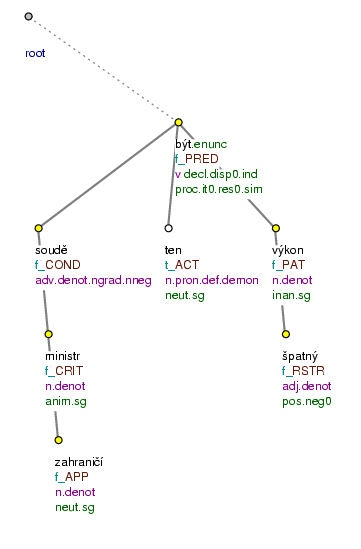
Soudě podle ministra zahraničí, je to špatný výkon. (=lit. Judging according_to minister (of) foreign_affairs is it bad performance)
If an adjective modifying some other modification is connected (to the modification) by a subordinating conjunction, the conjunction + the adjective are considered a dependent verbal clause in which the verb is not expressed on the surface.
Thus, a new node is inserted into the structure in the position of the verb (#EmpVerb) and it gets a functor reflecting the meaning of the conjunction. The node representing the adjective depends on the empty verb as its Patient. The whole clause modifies another adjective or an entire noun phrase.
Examples:
Má svůj hluboký, <přestože> {#EmpVerb.CNCS} zkarikovaný.PAT smysl. (=It has got its deep, although twisted meaning) Fig. 6.52
Není moudré rozházet si to <byť> s {#EmpVerb.CNCS} potenciálním.PAT významným politikem. (=It is not wise to antagonize an important politician, though just a potential one) Fig. 6.53
Měřit něco platným, <byť> {#EmpVerb.CNCS} spleteným.PAT zákonem. (=To use a valid, though bad law)
levné, <protože> {#EmpVerb.CAUS} nepotřebné.PAT zboží (=cheap - because useless - goods)
